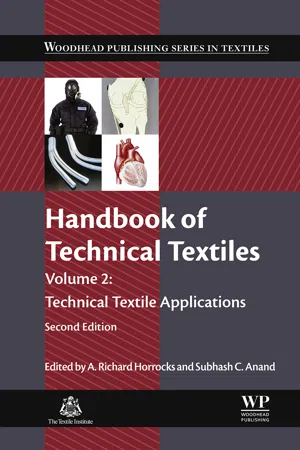1.1 Composite materials
Textile-reinforced composite materials (TRCMs) are part of the general class of engineering materials called composite materials. We can define composite materials as having two or more constituents at the macroscopic scale, such that the distribution and geometry of the constituents have been chosen to optimise one or more properties of the material. This is clearly an appropriate definition for textile-reinforced composites for which there is one phase, called the matrix, reinforced by a fibrous reinforcement in the form of a textile.
In principle, there are as many combinations of fibre and matrix available for textile-reinforced composites as there are available for the general class of composite materials. In addition to a wide choice of materials, there is the added factor of the manufacturing route to consider, since a valued feature of composite materials is the ability to manufacture the article at the same time as the material itself is being processed. This feature of composite materials contrasts with the other classes of engineering materials (metals, ceramics, polymers), where it is usual for the material to be produced first (e.g. steel sheet) followed by the forming of the desired shape.
The full range of possibilities for composite materials is very large. In terms of reinforcements, we must include S-glass, R-glass, a wide range of carbon fibres, boron fibres, ceramic fibres (e.g. alumina, silicon carbide), and aramid fibres and recognise that the reinforcement can come in the form of long (or continuous) fibres, short fibres, disks or plates, spheres, or ellipsoids. Matrices include a wide range of polymers (epoxides, polyesters, nylons, etc.), metals (aluminium alloys, magnesium alloys, titanium, etc.), and ceramics (SiC, glass ceramics, etc.). Processing methods include hand lay-up, autoclave, resin transfer moulding (RTM), injection moulding for polymer matrices, squeeze casting and powder metallurgy routes for metals, chemical vapour infiltration, and pre-pregging routes for ceramics. A reader interested in a general introduction to composite materials should consult one of a number of wide-ranging texts (e.g. Matthews and Rawlings,1 Hull and Clyne2).
The market for composite materials can be loosely divided into two categories: ‘reinforced plastics’ based on short fibre E-glass reinforced unsaturated polyester resins (which account for the bulk of composites usage) and ‘advanced composites’ which make use of the advanced fibres (carbon, boron, aramid, SiC, etc.), or advanced matrices (e.g. high temperature polymer matrices, metallic, or ceramic matrices), or advanced design or processing techniques. Even within these loosely defined categories, it is clear that textile composites are ‘advanced composites’ by virtue of the manufacturing techniques required to produce the textile reinforcement. This chapter will be mostly concerned with textile-reinforced polymeric matrices. The reader should be aware that ceramic fibres in a textile format which reinforce ceramic matrices are also possible (e.g. Kuo and Chou,3 Pryce and Smith4).
1.2 Textile reinforcement
1.2.1 Introduction
Textile-reinforced composites have been in service in engineering applications for many years in low profile, relatively low-cost applications (e.g. woven glass-reinforced polymer hulls for minesweepers). While there has been a continual interest in textile reinforcement during the last four decades, and increasingly since the 1980s, the recent desire to expand the envelope of composite usage has had a dramatic effect on global research into, and usage of, textile reinforcement. In addition to the possibility of a range of new applications for which textile reinforcement could replace metal technology, textile reinforcement is also in competition with relatively mature composite technologies which use the more traditional methods of pre-pregging and autoclave manufacture. This is because TRCMs show potential for reduced manufacturing costs and enhanced processability, with more than adequate, or in some cases improved, mechanical properties. In 2010, the major economic entities globally for the production of composite materials were split between Europe (with about 20% of global production), the USA (with about 22%), and China (with about 28%); the rest of the world accounted for about 29%.5 Within these markets, the interest in using textile-based composites of many different types has continued to grow. As a consequence, the first two decades of the 21st century have seen a rapid increase in the number of delegates at composite materials conferences, with large and well-attended sessions on textile reinforcement. In addition, there are composite material conferences dedicated to textile reinforcements (such as the TEXCOMP series).
Of the available textile reinforcements (woven, braided, knitted, stitched), many can now be considered to be mature applications. For example, non-crimp fabric (carbon fibre) is used to manufacture the A380 rear pressure bulkhead; at 240 kg, in mass, 6.2 m long, 5.5 m wide, and 1.6 m deep, this can be classed as a large structure; at a small...
